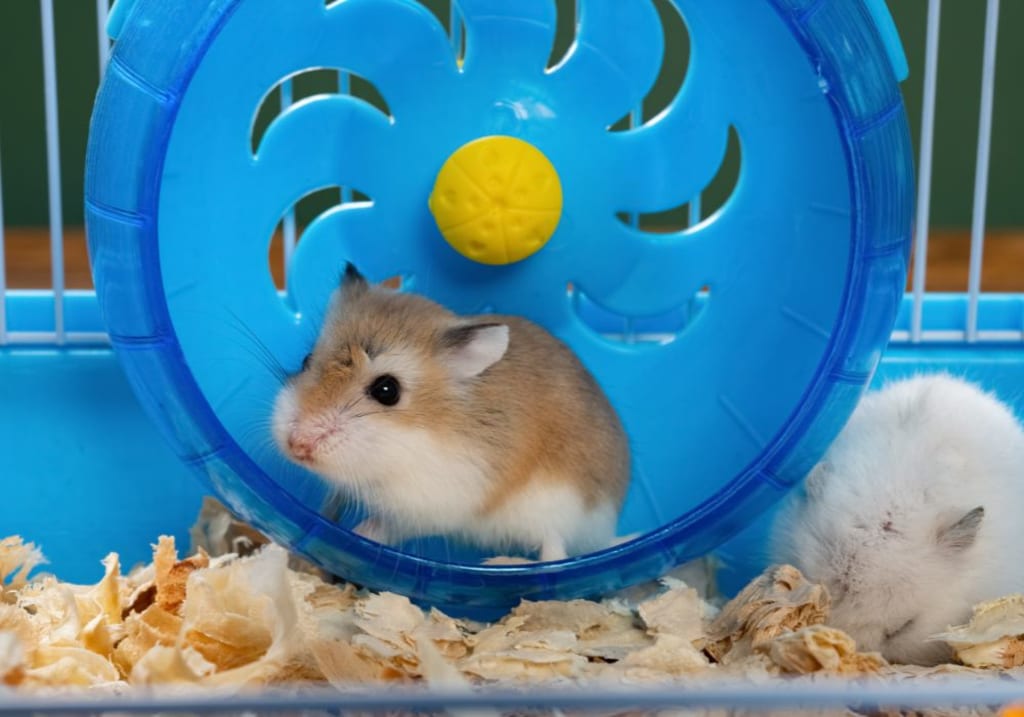
Maintaining a Healthy and Odor-Free Habitat for Your Furry Friend
Hamsters are beloved pets known for their adorable appearance and playful personalities. As responsible pet owners, it's essential to provide them with a clean and comfortable living environment. Regularly cleaning a hamster's cage is crucial for their health, well-being, and the overall cleanliness of your home. In this comprehensive guide, we'll explore the step-by-step process of cleaning a hamster cage, ensuring your furry friend's habitat is fresh, safe, and odor-free.
Understanding the Importance of Cage Cleaning
Hamsters are naturally clean animals, but their cages can quickly become soiled due to their natural behaviors, such as burrowing, eating, and eliminating waste. Neglecting to clean the cage can lead to several issues, including:
- Odor Control: Uncleaned cages can develop strong, unpleasant odors that can permeate your living space. Regular cleaning helps maintain a fresh and pleasant environment for both you and your hamster.
- Respiratory Health: Ammonia and other gases produced by urine and feces can be harmful to a hamster's delicate respiratory system, potentially leading to respiratory infections or other health problems.
- Parasite Prevention: Dirty cages can harbor parasites, bacteria, and other pathogens that can threaten your hamster's health. Proper cleaning helps eliminate these risks.
- Behavioral Issues: A dirty, cluttered cage can cause stress and anxiety in hamsters, leading to behavioral problems such as excessive burrowing, aggression, or even self-mutilation.
By understanding the importance of regular cage cleaning, you can ensure your hamster's living environment is safe, comfortable, and conducive to their overall well-being.
Gathering the Necessary Supplies
Before you begin the cleaning process, make sure you have all the necessary supplies on hand. This will help you work efficiently and effectively. The essential items you'll need include:
- Hamster-safe cleaning products: Look for non-toxic, fragrance-free cleaning solutions specifically designed for small animal habitats. Avoid harsh chemicals, bleach, or products with strong scents.
- Cleaning tools: Gather a small brush, a scoop or shovel, paper towels or clean rags, and a trash bag.
- Fresh bedding: Prepare a sufficient amount of high-quality, absorbent bedding material, such as aspen shavings, paper-based bedding, or a combination of both.
- Water and food bowls: Have clean, disinfected water and food bowls ready to replace the old ones.
- Hamster toys and accessories: Gather any toys, tunnels, or other accessories that need to be cleaned or replaced.
By having all the necessary supplies ready, you can ensure a smooth and efficient cleaning process, minimizing the time your hamster spends outside of their habitat.
Step-by-Step Guide to Cleaning a Hamster Cage
Cleaning a hamster cage can be a straightforward process, but it's important to follow the right steps to ensure your furry friend's safety and comfort. Here's a step-by-step guide to help you:
1. Prepare the Workspace
Choose a clean, well-ventilated area to work in, such as a table or countertop.
Lay down a clean towel or paper towels to create a clean, absorbent surface.
2. Remove the Hamster
Gently transfer your hamster to a secure, temporary holding container, such as a small cardboard box or a hamster-safe travel carrier.
Ensure the holding container has adequate ventilation and is lined with a soft, absorbent material.
3. Remove Soiled Bedding
Using the scoop or shovel, carefully remove all the soiled bedding from the cage, taking care not to disturb any of your hamster's burrows or nesting areas.
Dispose of the used bedding in a trash bag.
4. Clean the Cage
Wipe down the interior surfaces of the cage, including the walls, floor, and any shelves or platforms, using a small brush and the hamster-safe cleaning solution.
Rinse the cage thoroughly with clean water to remove any residual cleaning solution.
Dry the cage completely using paper towels or clean rags.
5. Disinfect the Cage
Once the cage is clean, use a diluted, hamster-safe disinfectant solution to wipe down all surfaces.
Allow the disinfectant to sit for the recommended time, then rinse the cage thoroughly with clean water.
Dry the cage completely before proceeding.
6. Replace the Bedding
Add a fresh layer of high-quality bedding material to the cage, ensuring it is evenly distributed and at least 2-3 inches deep.
Fluff the bedding to create a comfortable, absorbent surface for your hamster.
7. Refresh Accessories
Clean any toys, tunnels, or other accessories by wiping them down with the hamster-safe cleaning solution and allowing them to air dry.
Replace any heavily soiled or damaged items.
8. Replenish Food and Water
Refill the clean water and food bowls with fresh, clean supplies.
Ensure the bowls are securely placed in the cage to prevent spills or tipping.
9. Return the Hamster
Gently transfer your hamster back into the clean, freshly prepared cage.
Observe your hamster's behavior to ensure they are comfortable and adjusting well to their new, clean environment.
By following these steps, you can ensure your hamster's cage is thoroughly cleaned, disinfected, and ready for your furry friend to enjoy a healthy, odor-free habitat.
Frequency of Cage Cleaning
The frequency of cage cleaning for hamsters can vary depending on several factors, including the size of the cage, the number of hamsters housed, and the amount of activity and waste produced. As a general guideline, it's recommended to clean the cage:
- Spot Clean Daily: Perform a quick spot clean every day to remove any visible soiled bedding, uneaten food, or other waste. This helps maintain a clean and healthy environment.
- Full Clean Weekly: Conduct a thorough, full cage cleaning once a week. This involves removing all the bedding, cleaning and disinfecting the cage, and replacing with fresh bedding.
- Deep Clean Monthly: Every 4-6 weeks, perform a deep clean of the cage. This includes disassembling the cage, thoroughly cleaning and disinfecting all components, and replacing any worn or damaged accessories.
It's important to note that the frequency of cleaning may need to be adjusted based on your individual hamster's needs and the specific conditions of their habitat. If you notice an increase in odor, excessive soiling, or any signs of health issues, you may need to clean the cage more frequently.
Tips for Effective Cage Cleaning
To ensure the best results and maintain a clean, healthy environment for your hamster, consider the following tips:
- Use the Right Cleaning Products: Opt for non-toxic, fragrance-free cleaning solutions specifically designed for small animal habitats. Avoid harsh chemicals, bleach, or products with strong scents that can be harmful to your hamster.
- Maintain Proper Ventilation: When cleaning the cage, work in a well-ventilated area to minimize your hamster's exposure to any cleaning fumes or dust.
- Avoid Disrupting Nesting Areas: Be gentle and mindful when removing soiled bedding, as hamsters can become stressed if their nesting areas are disturbed.
- Introduce Changes Gradually: If you need to replace any accessories or change the type of bedding, do so gradually to help your hamster adjust to the new environment.
- Observe Your Hamster's Behavior: Monitor your hamster's behavior and health after a cleaning to ensure they are comfortable and adjusting well to their freshened-up habitat.
- Establish a Cleaning Routine: Stick to a consistent cleaning schedule to maintain a clean, healthy environment for your hamster and prevent the buildup of odors or waste.
By following these tips, you can ensure your hamster's cage is cleaned effectively, and your furry friend can thrive in a safe, comfortable, and odor-free habitat.
Troubleshooting Common Cage Cleaning Challenges
While the process of cleaning a hamster cage may seem straightforward, you may encounter some challenges along the way. Here are some common issues and how to address them:
- Stubborn Odors: If you're still experiencing persistent odors even after a thorough cleaning, try the following:
- Ensure you're using the right cleaning products and replacing the bedding regularly.
- Check for any hidden areas of urine or feces that may have been missed.
- Consider upgrading to a larger cage or adding more ventilation to the habitat.
- Excessive Bedding Consumption: If your hamster seems to be consuming or burrowing through the bedding at a rapid rate, try the following:
- Experiment with different types of bedding to find the one your hamster prefers.
- Provide more nesting material, such as shredded paper or hay, to satisfy their natural burrowing instincts.
- Adjust the depth of the bedding to find the optimal level for your hamster's comfort and needs.
Hamster Stress or Anxiety: If you notice your hamster exhibiting signs of stress, such as excessive burrowing, aggression, or self-mutilation, consider the following:
- Minimize disruptions to their habitat during the cleaning process.
- Introduce changes gradually and allow your hamster time to adjust.
- Ensure the cage is large enough to provide ample space for your hamster to move and burrow.
Difficulty Accessing Hard-to-Reach Areas: If you're struggling to clean certain areas of the cage, try the following:
- Use a small brush or toothbrush to reach tight spaces and corners.
- Disassemble the cage, if possible, to access all surfaces thoroughly.
- Consider upgrading to a cage with fewer nooks and crannies that can be more easily cleaned.
- By addressing these common challenges, you can ensure your hamster's cage remains clean, odor-free, and conducive to their overall health and well-being.
Conclusion
Maintaining a clean and healthy hamster cage is essential for your furry friend's well-being and the overall cleanliness of your living space. By following the step-by-step guide and tips outlined in this comprehensive article, you can effectively clean and maintain your hamster's habitat, ensuring a fresh, safe, and odor-free environment for your beloved pet.
Remember, regular cage cleaning, the use of appropriate cleaning products, and observing your hamster's behavior are key to providing a comfortable and thriving home for your hamster. With a little time and effort, you can keep your hamster's cage in top-notch condition, allowing your furry companion to enjoy a happy and healthy life.
About the Creator
Hasan
Welcome...
In this site of mine you can learn amazing things and many information that you don't know so please subscribe to my site.
Enjoyed the story? Support the Creator.
Subscribe for free to receive all their stories in your feed.






Comments
There are no comments for this story
Be the first to respond and start the conversation.